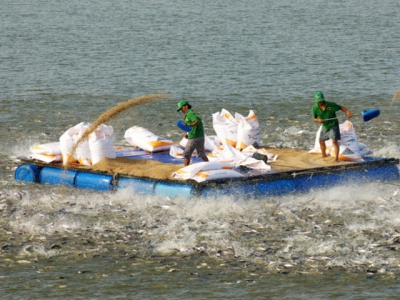Possibilities of breaking the export chain of fisheries products

Over half of the River Delta's tra fish (pangasius) factories and aqua product plants in the Southeast were forced to shut down. The dangers of interrupting the export seafood supply chain are obvious.
According to the Vietnam Association of Seafood Exports and Processing (VASEP), the immunization rate for Covid-19 has been between 40% and 50% in processing and seafood export companies. Ca Mau was the locality with the quickest and most vaccination registrations.
Beginning in late July, as the pandemic spread to Mekong Delta provinces, regional tra fish processing companies were the hardest hit, with up to 50% of enterprises in key zones ceasing operations.
As a result of the closure and decrease of maximum capacity, the fish produced in the ponds of those companies were oversized. In certain companies that raise tra fish, the farming period is extended and the density is excessive, resulting in the daily death of dozens of tons of fish. At now, the total capacity of the tra fish industry is believed to be between 10% and 20%.
According to reports from shrimp processing businesses in Ca Mau, Soc Trang, and Bac Lieu, the three provinces with the highest volume of shrimp production in the country, the Covid-19 pandemic situation developed unexpectedly, and the social distancing order hampered product circulation, seed trading, and shrimp farming, while factories reduced their processing capacity by 60%–70%.
Almost all seafood processing companies in Hay Giang have closed due to their inability to fulfill the criteria of the "three on-sites" motto, a shortage of workers, and a challenge with circulation.
Numerous processing plants are situated in the "red zone," which prohibits all employees from the "green zone" from entering.
Initially, several manufacturers attempted to follow the "three on-sites" motto to preserve employment and to satisfy contracts and signed orders. They were, however, forced to close after one month owing to exorbitant costs such as motel rentals, dormitory accommodation, wages, food, medical care, and medical testing...
Following a time of social distancing in Da Nang, the area's seafood processing companies ceased operations. Some are expected to follow the "three on-sites" motto to maintain output, although there is a severe labor shortage for deep processing.
Certain shrimp companies in Da Nang are resolved to restart, purchasing just raw shrimp for the production of basic PD shrimp items. However, the price of this type of Vietnam cannot match that of India or Ecuador markets.
Enterprises in coastal areas like as Binh Dinh, Phu Yen, Khanh Hoa, Ba Ria - Vung Tau, and Kien Giang have reduced processing capacity and operate in moderation. Both fishermen and companies face significant challenges as a result of the closure of many fishing ports due to Covid-19 infections.
The percentage of employees and workers in the fishing sector who have been vaccinated remains very low in several coastal regions, and the expense of the "three on-sites" procedure is prohibitively expensive. As a result, several companies have contemplated ceasing operations entirely if, before September 15, the pandemic situation in areas remains unavoidable and social distancing restrictions remain in place.
VASEP examined 100% of companies and found that the "three on-sites" mantra is just a temporary solution for businesses to sustain output. If the Government and local governments do not take immediate action to restore, the danger of the whole production chain collapsing from agriculture to exploitation, processing, trade, import, and export is inevitable.
According to many shrimp processing and export companies, the Vietnamese shrimp sector has fallen behind market possibilities as a result of Covid-19.
However, if communities can rapidly find ways to manage the pandemic and restore output by the end of August, there are still possibilities and shrimp prices will rise again. And if it is later, consider the chance for this year to have passed.
September marks the start of the peak season for shrimp factories in terms of raw material acquisition, processing, and export. However, given the present state of affairs, it seems likely that shrimp supply will be reversed and reduced until the end of the year, perhaps into 2022.
Related news
 Seafood exports plummeted in the first half of August
Seafood exports plummeted in the first half of August Seafood exports saw good growth in the first 7 months but plummeted in the first half of August due to Covid-19 in southern provinces and cities.
 Seafood industry must recover before September 15 to achieve its export target
Seafood industry must recover before September 15 to achieve its export target Seafood exports have been strongly impacted by the pandemic. With the characteristics of the chain production industry, seafood businesses believed
 Increase freezing storage for seafood
Increase freezing storage for seafood Binh Thuan strengthens solutions for storing and freezing seafood, solving immediate difficulties in consumption, ensuring long-term raw materials for processin